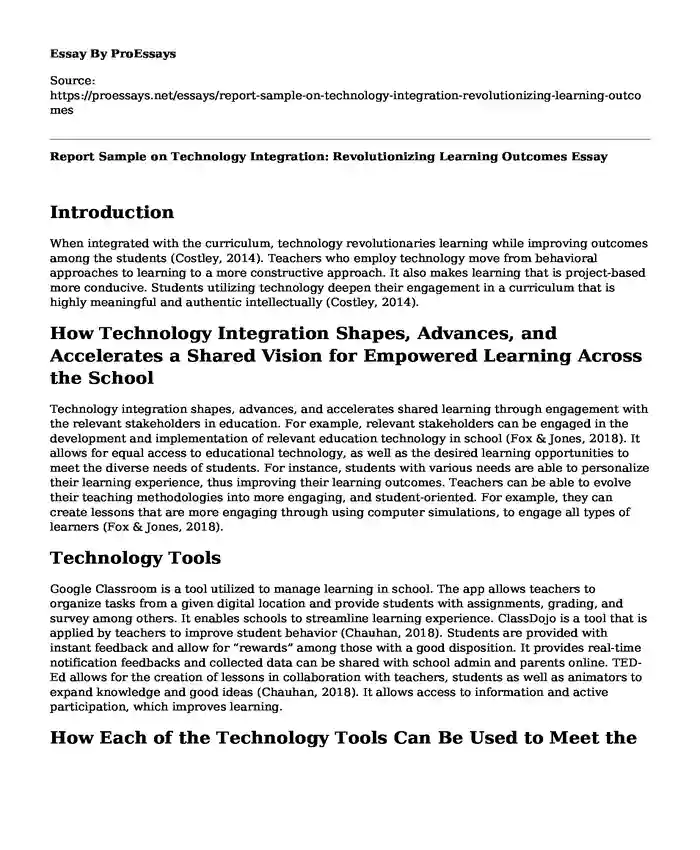Introduction
When integrated with the curriculum, technology revolutionaries learning while improving outcomes among the students (Costley, 2014). Teachers who employ technology move from behavioral approaches to learning to a more constructive approach. It also makes learning that is project-based more conducive. Students utilizing technology deepen their engagement in a curriculum that is highly meaningful and authentic intellectually (Costley, 2014).
How Technology Integration Shapes, Advances, and Accelerates a Shared Vision for Empowered Learning Across the School
Technology integration shapes, advances, and accelerates shared learning through engagement with the relevant stakeholders in education. For example, relevant stakeholders can be engaged in the development and implementation of relevant education technology in school (Fox & Jones, 2018). It allows for equal access to educational technology, as well as the desired learning opportunities to meet the diverse needs of students. For instance, students with various needs are able to personalize their learning experience, thus improving their learning outcomes. Teachers can be able to evolve their teaching methodologies into more engaging, and student-oriented. For example, they can create lessons that are more engaging through using computer simulations, to engage all types of learners (Fox & Jones, 2018).
Technology Tools
Google Classroom is a tool utilized to manage learning in school. The app allows teachers to organize tasks from a given digital location and provide students with assignments, grading, and survey among others. It enables schools to streamline learning experience. ClassDojo is a tool that is applied by teachers to improve student behavior (Chauhan, 2018). Students are provided with instant feedback and allow for “rewards” among those with a good disposition. It provides real-time notification feedbacks and collected data can be shared with school admin and parents online. TED-Ed allows for the creation of lessons in collaboration with teachers, students as well as animators to expand knowledge and good ideas (Chauhan, 2018). It allows access to information and active participation, which improves learning.
How Each of the Technology Tools Can Be Used to Meet the Needs of Diverse Students
Google Classroom, ClassDojo, and TED-Ed are technology tools that allow customization to meet the needs of every student. Teachers are tasked with identifying each of the student needs and then interpreting those needs into the tool with the help of an IT specialist. These specialists can customize these tools such that they are inclusive in all aspects of learning and with the desired outcome both for the students and teachers (US Department of Education, 2017).
Modeling a Class Activity
ClassDojo allows students, teachers as well as their school leaders and parents to connect. One activity that can be performed is the sharing of class information (Chauhan, 2018). Using the app, students upload and display their photos or videos using Ios, Android, or computer devices. The teachers on the other hand utilize projectors to cast the uploaded material into a smart board. To create groups, the teacher applies statistical tools in the app to randomly pair students for a task while displaying the task on the board or class computer.
Conclusion
To support technology integration the school can source funds by signing in to fundraising platforms such as donorschoose.org and oradoptaclassroom.org by presenting their needs to the donors. The other source is through Teacher Gift Exchange that requires teachers to sign up for supplies, thus allowing the school to be gifted by willing supporters. The school can also appeal to existing corporations for donations. Organizations such as Bill and Melinda Gates are known to sponsor such programs.
References
Chauhan, A. (2018). 11 Digital Education Tools For Teachers And Students - eLearning Industry. eLearning Industry. Retrieved 10 August 2020.
https://elearningindustry.com/digital-education-tools-teachers-students.
Costley, K. C. (2014). The Positive Effects of Technology on Teaching and Student Learning. Online Submission.
https://files.eric.ed.gov/fulltext/ED554557.pdf.
Fox, C., & Jones, R. (2018). Navigating the Digital Shift 2019: Equitable Opportunities for All Learners. State Educational Technology Directors Association.
https://files.eric.ed.gov/fulltext/ED599408.pdf.
US Department of Education. (2017). Reimagining the role of technology in education: 2017 national education technology plan update.
https://tech.ed.gov/files/2017/01/NETP17.pdf.
Cite this page
Report Sample on Technology Integration: Revolutionizing Learning Outcomes. (2023, Nov 06). Retrieved from https://proessays.net/essays/report-sample-on-technology-integration-revolutionizing-learning-outcomes
If you are the original author of this essay and no longer wish to have it published on the ProEssays website, please click below to request its removal:
- Summary of Fine Motor Activities in Head Start and Kindergarten Classrooms
- The Relationship Between Graduate Attributes and Employability Essay
- Time Management Strategy: Managing My Schedule Paper Example
- Essay Sample on Classroom Activities Before Christmas
- Developmental Red Flags - Essay Sample
- Our Lean Start-Up Assignment: How Teamwork Achieved Success - Essay Sample
- American Education System: Inadequate Funding, Poor Teaching, and Unintelligent Students - Essay Sample







